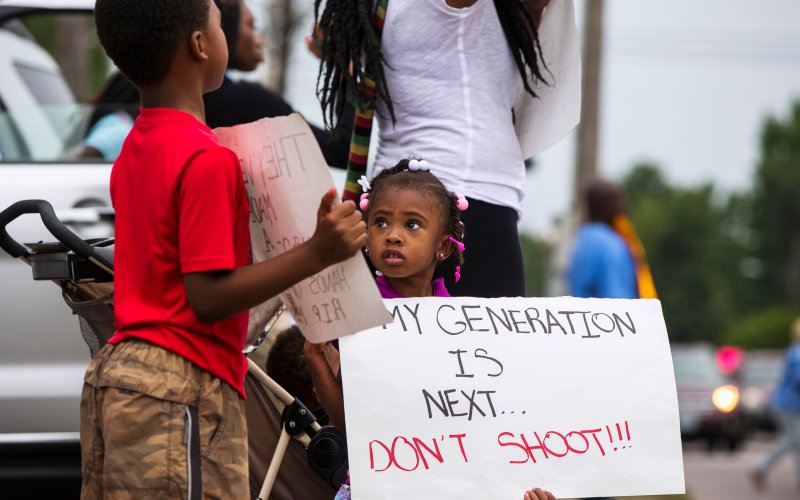
It’s Not Just Teens Like Michael Brown—Even Small Black Children Are Suspect
Heard about the 6-year-old girl who was cuffed and arrested? Or the 9-year-old hauled off to jail? Just guess what they had in common.
When Salecia Johnson threw a tantrum in her kindergarten class in Georgia, police were called to the scene and the 6-year-old girl was handcuffed and arrested. When my daughter threw a tantrum in her kindergarten class in New York, including hitting another student, all that happened was her teacher called me that evening to discuss it. What’s the difference? There may be a number of them, but the one that stands out is that Salecia Johnson is black, and my daughter is white.
And before you think Johnson’s is an isolated story, another African-American girl was handcuffed by police for acting out in her kindergarten class in Florida. And a 9-year-old black girl was handcuffed and hauled off to jail by police in Oregon. Not that it should matter, but the Oregon girl was a straight A student in the school’s gifted program. She was taken into custody and booked by police, including fingerprints and a mug shot.
In the wake of the shooting death of Michael Brown in Ferguson, I keep thinking about the radically different life experiences of white kids and black kids in America today—how white kids are given the benefit of the doubt while black kids are inherently viewed with suspicion. That leads to all kinds of unequal treatment—including, sometimes, death.
According to the Christian Science Monitor, “Two students set off fire alarms in the same school. One of them, an African-American kindergartner, is suspended for five days; the other, a white ninth-grader, is suspended for one day.”
Or, “Two middle-schoolers push each other; the white student receives a three-day, in-school suspension, while the native American student is arrested and suspended, out of school, for 10 days.”
It’s not just anecdotal. In a federal study from 2013 in which African Americans made up 18 percent of the total student body, they accounted for 46 percent of students suspended more than once, 39 percent of students expelled and 36 percent of students arrested at school. Another comprehensive study from this year supports the conclusion that racial disparities in discipline are not due to higher rates of offenses by black children.
 In this April 16, 2012 image made from video and provided by WMAZ-13 TV, Salecia Johnson, 6, is shown at her home near Milledgeville, Ga. Police handcuffed the kindergartner after the girl threw a tantrum, and the police chief is making no apologies. (AP Photo/WMAZ-13 TV)
In this April 16, 2012 image made from video and provided by WMAZ-13 TV, Salecia Johnson, 6, is shown at her home near Milledgeville, Ga. Police handcuffed the kindergartner after the girl threw a tantrum, and the police chief is making no apologies. (AP Photo/WMAZ-13 TV)That disparate treatment carries into adulthood. For instance, while white folks and black folks use illicit drugs at comparable rates, black Americans are 3.6 times more likely to be arrested for drug use than white Americans. And once convicted, blacks are dealt longer sentences than whites. This is due to racial bias, plain and simple.
My 5-year-old white daughter could be the same age as Michael Brown, even the same size and gender, and yet because of race, her behavior would be interpreted entirely differently. When shown the exact same computer-generated faces, with only the skin color changed, people are more likely to rate black faces as more hostile than white faces. When people are shown a video in which one person is shoving another person, if the “shover” is black and the “victim” is white, 75 percent of people say the push is aggressive. But when the “shover” is white and the “victim” is black, only 17 percent say the push is aggressive. Did Officer Darren Wilson reasonably fear for his life, the legal standard to justify deadly force? That “fear” is also racialized, whether Wilson was aware of it at the moment or not. My white daughter simply could never be seen as “scary” in the same way.
By the same token, if my daughter were a young adult protesting with a group of other white folks, she would likely be treated differently by the media and police. For instance, in Ferguson, where most of the protesters are black, though the vast majority have been peaceful, media coverage has overemphasized a handful of looters and violent protesters and the government has mounted a military-scale response including tanks and the National Guard. Consider on the other hand when the mostly white students of Penn State protested following the firing of football coach Joe Paterno. The demonstrators tore down public property, including a lamppost that fell into a crowd, and threw rocks and fireworks at the police. The police responded with pepper spray—not tear gas or rubber bullets or tanks or curfews.
















